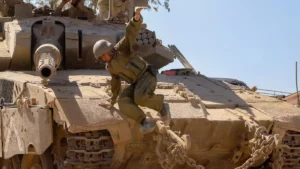Hamas' strategy has been more effective than was deemed possible nine months ago. Israel now has a real war on its hands, and on all fronts. It cannot easily be stopped

An Israeli soldier jumps from a tank in area near the border with the Gaza Strip on 2 July, 2024
David Hearst writes in
Middle East Eye 4 July 2024

One of the main questions about Hamas’ 7 October attacks remains unanswered to this day.
What did Hamas think would happen if it struck Israel on this scale?
Initially, I bought the chaos theory. It went as follows. A limited operation to hit Israeli military targets and take high-value hostages spiralled out of control, thanks to the unexpected collapse of Israel’s Gaza Brigade. Hamas expected most of the 1,400 fighters it sent over the fence that day to be killed. Most of them returned alive.
As Hamas and other armed groups ran out of preordained targets, they fanned out and stumbled across a music festival they did not know was there. The ensuing carnage became, in the words of one Gulf diplomat: “the mother of all miscalculations”.
As each month of this war succeeds the last, I am less and less certain that this theory is correct.
It did indeed gain traction in the immediate aftermath of the Hamas attack, as Hamas’ allies failed to follow its lead.
On the day his forces struck, Hamas’ military commander, Mohamed Deif, called on the “axis of resistance” allies to join the struggle: “Our brothers in the Islamic resistance in Lebanon, Iran, Yemen, Iraq and Syria, this is the day when your resistance unites with your people in Palestine,” he said in an audio message that had been prepared some time before.
But Hezbollah, for one, was less than enamoured at the prospect of entering a war which was not of their timing or choosing. Like Israel’s Gaza Brigade, Hezbollah had been taken by surprise.
Its fighters were not even on alert in the villages near the border with Israel: “We woke up to a war,” said one commander. Clearly, a measured response from Hezbollah was not in the Hamas script. All Hamas had to do after 7 October was to wait, keep on fighting and let Israel’s natural aggression and arrogance towards its neighbours do Hamas’ work
Two weeks passed before Khaled Meshaal, who heads Hamas’ office in the diaspora, thanked Hezbollah for its response so far, but added pointedly that “the battle requires more”.
Hassan Nasrallah, Hezbollah’s secretary-general, kept his silence for three more long weeks before declaring that the Hamas operation was “100 percent Palestinian in terms of both decision and execution”.
“This operation has no bearing on any decision or move to be taken by any other faction within the resistance axis,” Nasrallah said.
It was a point rammed home when Ayatollah Ali Khamenei told Ismail Haniyeh, Hamas’ political leader, that Iran would not intervene directly although it would continue to lend the group its political and moral support.
By now we were in mid-November, and Hamas’ strategy in starting what it plainly intended to be a regional war appeared to be foundering.
Dam burst
Compare that situation in November to the words and deeds of Hezbollah and Iran now.
As Israel pre-emptively struck more and more Hezbollah targets, the Lebanese group replied in kind. Yemen’s Ansarallah movement (the Houthis) entered the fray in November with attacks on shipping in the Red Sea.
The turning point came in April when Israel struck a compound of the Iranian embassy in Damascus, killing Brigadier General Mohammad Reza Zahedi, the officer in charge of the Quds Force’s overseas operations, and 15 others, including seven other Islamic Revolutionary Guard Corps (IRGC) officers.
Iran launched a massive response – 170 drones, 30 cruise missiles and as many as 120 heavy ballistic missiles directly at Israeli targets, several of which hit Israeli military bases.
A rubicon had been crossed, and the ground for a regional war clearly laid. From then on it was a matter of when, not if.
On Tuesday, the head of the IRGC’s Aerospace Force, Brigadier General Amir Ali Hajizadeh, said Iran was itching for another opportunity to do the same.
Today, Hezbollah stands on the brink of war, with Nasrallah warning Israel that hundreds of thousands of other fighters were willing to join up – help which Hezbollah did not need at the moment. He even threatened to attack Cyprus if it allowed Israeli war planes to use its bases.
It turned out that all Hamas had to do after 7 October was to wait, keep on fighting and let Israel’s natural aggression and arrogance towards its neighbours do Hamas’ work for it.
Its strategy is working. But was this strategy cobbled together in the aftermath of a botched raid, as everyone had thought on 7 October?
Apparently not. Look back over the speeches of Yehya Sinwar, the leader of Hamas in Gaza.
Read More »


